
The Clinton Global Initiative (CGI) is always a big event for us. Why? Because the star-studded four-day, annual meeting in New York focuses on major development challenges affecting many of our markets - such as poverty, climate change, unemployment, and disease - and we want to do our part to help.
2014 marks my tenth year attending the CGI. When former US President William J. Clinton first launched the initiative back in 2005, it broke down many of the silos that existed within the development community. Policy makers, academics, and private sector leaders began to have honest discussions. Relationships began, and partnerships emerged.
Without CGI, we might not have seen such a collective effort to tackle some of the world's most pressing challenges. But some areas experienced a lag in collaborative action. Take the subject of women and girls. At CGI, women and girls wasn't a specific focus area until 2009. And even then, it was a more marginal topic.
As a key segment to unlocking poverty reduction, positive health outcomes, and economic growth - some of the main world problems that CGI aims to tackle - adolescent girls were not getting the attention they should.
I still remember the first 'Women and Girls' breakout session - only women attended, and the conversation focused more on women than on girls.
Ten years into the CGI journey, everything has changed. Talking about women and girls in sessions attended by men and women is now the norm, and the difference this has made is huge.
The critical change point
CGI now applies a gender lens to everything being discussed: poverty, health, education, and economics. The forum has finally acknowledged that women and girls could be a game changer to solving global issues.
We have gone from talking about 'women and girls' to 'girls and women'. The 'Girl Effect' has become a theme in most conversations, and investment in girls' education has sky-rocketed.
And now, once again, the conversation is shifting. The first substantive event of this year's CGI was about how we engage boys and men as allies for women and girls. The four panellists were all men.
Why a bank cares
You might wonder why a bank cares about the girls agenda at all. The simple truth is empowering girls is not only a moral imperative - it's an economic one too. Companies have definite stake in ensuring girls have equal access to education and employment.
Adolescence is a critical period for women. Often, by the time a woman reaches her twenties, she will already have missed out on schooling or saving the money for starting a business or taking a degree.
If companies miss the window of opportunity, it means there are fewer women in the talent pipeline and fewer female customers.
With girls and women now being considered as part of every development challenge discussed at CGI, we hope more companies doing business in developing countries will invest in girls' education. Based on my conversations over the past few days, the signs are encouraging.